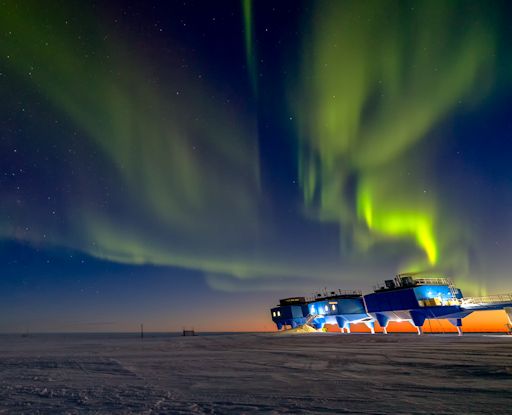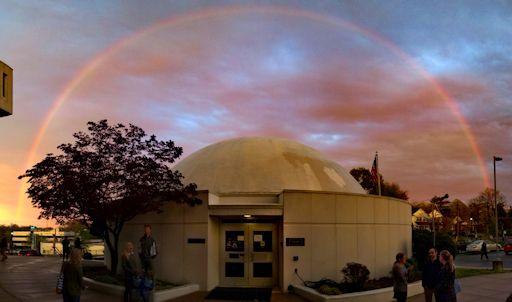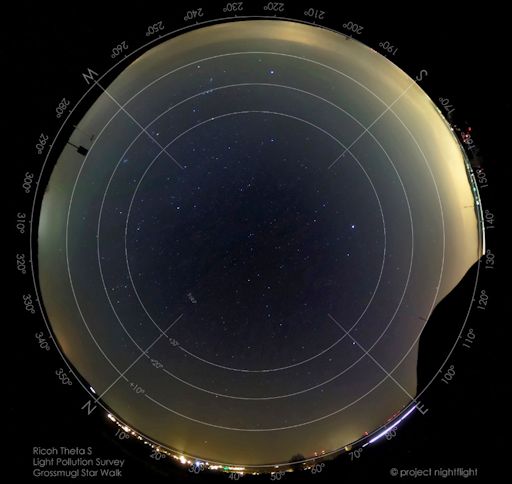Marianne's Heaven On Earth Aurora Chaser Tours Chasethelighttours.co.uk invites you to join them in their quest to find and photograph the Aurora Borealis. Experience the winter wonderland in the Tromsø Area. | | | CHANCE OF MINOR STORMS TODAY: NOAA forecasters say there is a a 45% chance of G1-class geomagnetic storms today, April 5th, as Earth enters a moderately-fast stream of solar wind. Arctic sky watchers should be alert for auroras in the waxing Spring twilight. Aurora alerts: text or voice ANTARCTIC LIGHTS: When the sun goes down over Halley Research Station in Antarctica, the darkening sky usually turns an icy shade of sunset red. On April 2nd, the primary color was, instead, green: 
"The auroras were incredibly fast moving and at times covered with entire sky," says photographer Greig Lawson, the station's doctor, who ventured out onto the ice during a G2-class geomagnetic storm. "They were clearly visible even while the sun was still setting." Operated by the British Antarctic Survey, the Halley Research Station is known for its studies of ozone, cosmic rays, and climate change. It is located on the Brunt Ice Shelf, a 130 meter thick slab of frozen water that floats atop the Weddell Sea. Such a platform is a dangerous place to be. Pieces of the shelf frequently break off, or "calve," giving birth to new icebergs. The current base structure, Halley VI, can avoid unstable ice by relocating itself. The station's colorful modules are built upon huge hydraulic skis. Lawson will be busy in the months ahead tending to the station's wintertime staff of 16. Hopefully, he'll have time send more pictures. As the Arctic brightens, making Northern Lights difficult to see, the Antarctic will darken, providing a velvety canvas for geomagnetic storms to paint their colors on southern skies. Realtime Aurora Photo Gallery BIG RED RAINBOW: Sometimes clouds and rain vex astronomers. On April 4th, they had the opposite effect. "I am the director of the David M. Brown Planetarium," says Jonathan Harmon of Arlington, Virginia. "As I was preparing to open the doors for a Monday evening star show inside, I had to delay due to the amazing show outside." The show was a big red rainbow: 
"I had to stitch 4 images together to catch the full arch over the planetarium dome," says Harmon. Harmon's rainbow towered so high in the sky because the sun was hanging so low. Rainbows are always centered on the point directly opposite the sun. As the sun sets, the rainbow rises. Sunset is also the reason for the rainbow's red hue. Sunlight illuminating raindrops behind the observatory were reddened by scattering from low-hanging air molecules and dust particles. Red sunlight makes red rainbows; it's as simple as that. Realtime Space Weather Photo Gallery SPHERICAL ASTRONOMY CAMERA: Astrophotographers are increasingly impressed by a new camera on the market. It's the Ricoh Theta S, and it can take spherical images and videos under a wide range of astronomical conditions. The students of Earth to Sky Calculus have used it to photograph the edge of space from a freezing helium balloon flying 117,000 feet above Earth, as well as a total eclipse of the sun from a balmy beach only a few feet above sea level in Indonesia. Last week in Europe, photographers Karoline Mrazek and Erwin Matys found a new use for the Ricoh Theta S. "It makes a great survey instrument for light pollution," they say. Click on the image for a 360-degree view: 
"We did an exposure at Star Meadow, the endpoint of the Grossmugl Star Walk in Austria," they explain. "It shows that the environment is 'clouded' by light pollution as much as 20 degrees above the horizon. This will help us plan future observing sessions at this otherwise dark-sky site." Mrazek and Matys are founding members of the astrophotography group project nightflight. They've been testing the Ricoh Theta S in many settings for night-sky photography. Their complete report on spherical astrophotography is highly recomended. Read it here. Realtime Spaceweather Photo Gallery Realtime Comet Photo Gallery
Solar Eclipse Photo Gallery
Every night, a network of NASA all-sky cameras scans the skies above the United States for meteoritic fireballs. Automated software maintained by NASA's Meteoroid Environment Office calculates their orbits, velocity, penetration depth in Earth's atmosphere and many other characteristics. Daily results are presented here on Spaceweather.com. On Apr. 5, 2016, the network reported 16 fireballs.
(16 sporadics)  In this diagram of the inner solar system, all of the fireball orbits intersect at a single point--Earth. The orbits are color-coded by velocity, from slow (red) to fast (blue). [Larger image] [movies] Potentially Hazardous Asteroids ( PHAs) are space rocks larger than approximately 100m that can come closer to Earth than 0.05 AU. None of the known PHAs is on a collision course with our planet, although astronomers are finding new ones all the time. On April 5, 2016 there were 1690 potentially hazardous asteroids.  | Notes: LD means "Lunar Distance." 1 LD = 384,401 km, the distance between Earth and the Moon. 1 LD also equals 0.00256 AU. MAG is the visual magnitude of the asteroid on the date of closest approach. | | Cosmic Rays in the Atmosphere | | Situation Report -- Oct. 30, 2015 | Stratospheric Radiation (+37o N) | | Cosmic ray levels are elevated (+6.1% above the Space Age median). The trend is flat. Cosmic ray levels have increased +0% in the past month. | | Sept. 06: 4.14 uSv/hr (414 uRad/hr) | | Sept. 12: 4.09 uSv/hr (409 uRad/hr) | | Sept. 23: 4.12 uSv/hr (412 uRad/hr) | | Sept. 25: 4.16 uSv/hr (416 uRad/hr) | | Sept. 27: 4.13 uSv/hr (413 uRad/hr) | | Oct. 11: 4.02 uSv/hr (402 uRad/hr) | | Oct. 22: 4.11 uSv/hr (411 uRad/hr) | These measurements are based on regular space weather balloon flights: learn more. Approximately once a week, Spaceweather.com and the students of Earth to Sky Calculus fly "space weather balloons" to the stratosphere over California. These balloons are equipped with radiation sensors that detect cosmic rays, a surprisingly "down to Earth" form of space weather. Cosmic rays can seed clouds, trigger lightning, and penetrate commercial airplanes. Our measurements show that someone flying back and forth across the continental USA, just once, can absorb as much ionizing radiation as 2 to 5 dental X-rays. For example, here is the data from a flight on Oct. 22, 2015: 
Radiation levels peak at the entrance to the stratosphere in a broad region called the "Pfotzer Maximum." This peak is named after physicist George Pfotzer who discovered it using balloons and Geiger tubes in the 1930s. Radiation levels there are more than 80x sea level. Note that the bottom of the Pfotzer Maximim is near 55,000 ft. This means that some high-flying aircraft are not far from the zone of maximum radiation. Indeed, according to the Oct 22th measurements, a plane flying at 45,000 feet is exposed to 2.79 uSv/hr. At that rate, a passenger would absorb about one dental X-ray's worth of radiation in about 5 hours. The radiation sensors onboard our helium balloons detect X-rays and gamma-rays in the energy range 10 keV to 20 MeV. These energies span the range of medical X-ray machines and airport security scanners. | | The official U.S. government space weather bureau | | | The first place to look for information about sundogs, pillars, rainbows and related phenomena. | | | Researchers call it a "Hubble for the sun." SDO is the most advanced solar observatory ever. | | | 3D views of the sun from NASA's Solar and Terrestrial Relations Observatory | | | Realtime and archival images of the Sun from SOHO. | | | from the NOAA Space Environment Center | | | the underlying science of space weather | | 
